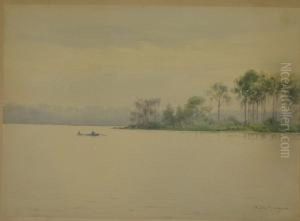Amelia Montague Watson Paintings
Amelia Montague Watson was an American artist and illustrator born in 1856, best known for her delicate watercolor paintings and illustrations. Her work often depicted scenes from her extensive travels, landscapes, and figures. Watson grew up in a time when it was uncommon for women to pursue a career in the arts, but she defied social conventions and carved out a successful career for herself.
Watson's artistic journey began at a young age, and she was likely influenced by the cultural milieu of the 19th century, which saw a flourishing of the arts and a growing acceptance of women artists in certain circles. She pursued her education in art and honed her skills, which would later allow her to contribute illustrations to various publications, one of the primary ways for artists to earn a living at the time.
During her lifetime, Watson traveled extensively, which had a significant impact on her work. She visited places like Japan, where she was one of the early American artists to live there. Her experiences abroad not only provided inspiration for her art but also allowed her to interact with other cultures and artistic traditions, which enriched her own style and subject matter. Watson's work from Japan is particularly notable for its sensitivity to the nuances of Japanese life and landscapes.
Watson never married, which was somewhat unusual for women of her era, and she dedicated her life to her art and her travels. Despite the challenges she faced as a woman in a male-dominated field, Watson achieved a degree of recognition during her lifetime, and her works were exhibited in various venues, including the Paris Salon, which was a significant accomplishment for any artist of that period.
After a long and productive career, Amelia Montague Watson died in 1934. While she may not be as well-known today as some of her contemporaries, her contributions to the field of illustration and watercolor painting remain noteworthy. Her legacy lives on through her artworks, which continue to be appreciated for their beauty and historical value.
